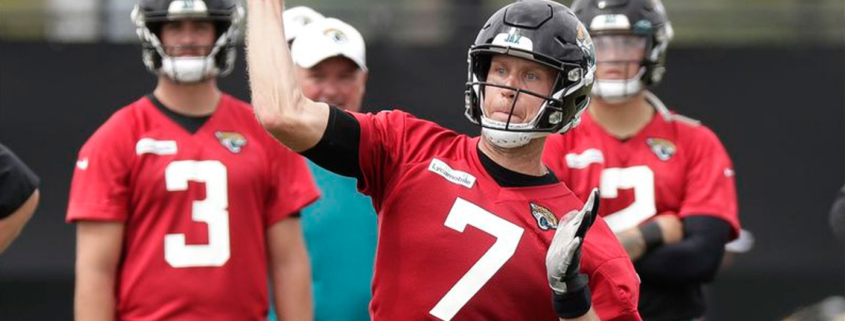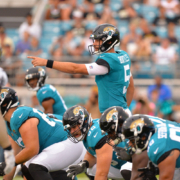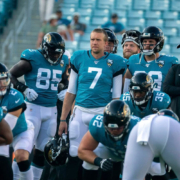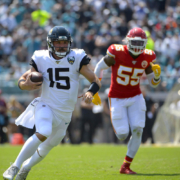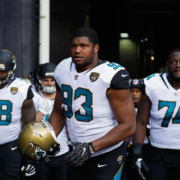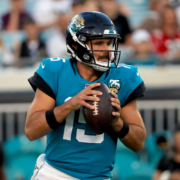Preseason Injuries Are The Worst
Doug Marrone is probably scared to death right now.
It’s got nothing to do with wins and losses, not scoring against the Ravens, what his team might do this year or his job security. He’s too good of a coach, too good of a guy, too well respected in the league and has been around long enough to know a lot of those things are out of his hands.
What he’s scared about is preseason injuries.
Whether they happen in conditioning, OTA’s, mini-camps, training camp or preseason games, Marrone admits to losing sleep over the possibility of players getting hurt on the last days of any offseason workouts.
“It drives coaches and head athletic trainers crazy,” says Mike Ryan, the Jaguars Head Athletic Trainer for the Jaguars for their first 20 years. “It’s a nerve racking time. Its one thing to lose a guy in October but if you lose a guy in training camp? The risks are higher than a regular season practice.”
That’s one of the reasons the Jaguars sat thirty-two players including most of the projected starters in the exhibition opener against the Ravens last Thursday night.
And Marrone is right to worry about injuries this time of year.
According to NFL research from the six years between 2012 and 2017, players average 81 concussions in the preseason. There are an average of 26 ACL and 43 MCL tears all before the real games even start.
“You can’t train enough to avoid a soft tissue injury,” says Matt Serlo, the Senior Clinical Director and
Licensed Physical Therapist at PT Solutions in Ponte Vedra.
Serlo has worked with hundreds of athletes from the NFL, the PGA Tour and other college and professional leagues over nearly three decades. He sees the progress their bodies can make quickly through hard work in rehabilitation. But he admits, those injuries are unpredictable.
“Sometimes guys can actually over train,” Serlo explained. “Those tendons and ligaments sometimes need a break. Sometimes going too hard and too quick makes it tough on their bodies.”
In the past week the Jaguars have lost rookie Tight End Josh Oliver to a hamstring problem, Linebacker Quincy Williams to a MCL tear and Linebacker James Onwualu is probably gone for the year with a knee injury suffered in practice in Baltimore. All three are players who were expected to contribute this year. Oliver and Williams have a chance to be starters.
“Hydration is a big part of it,” added Ryan who also owns Mike Ryan Sports Medicine and now is the Sports Medicine Analyst for Sunday Night Football and NBC Sports.
“There’s a direct correlation between hydration and soft tissue injuries. I’d give a talk before camp about supplements, legal supplements, anything that isn’t allowing you to hydrate properly.”
New technologies are available to every player in the NFL for rehab and recovery. Cutting edge stuff like hyperbaric chambers, cryotherapy tanks, compression boots, you name it, are all available. But sometimes it just comes down to simple rest that can make the difference.
“The hamstrings are some of the longest and strongest muscles in the body,” Serlo explained. The inflammation has to go down, the body needs rest. These guys want to push, push, push because they’re on a short timeline. The best treatment out there can’t change that over rest.”
With players trying to earn jobs for the year, unlike when the season starts, some guys are going a hundred miles an hour in practice. When you get guys that big changing direction at fifteen or 16 miles an hour, it doesn’t take an opposing impact to cause an injury.
“Players are sleep deprived, they’re under stress, their immune systems are down. They could be doing something they think helps them earn a job but it creates more problems than it helps,” Ryan explained. “I try and educate them on what to drink and what to eat to give them the best chance to stay healthy.”
Research shows that If you lose at little as 2% of your body weight your mental capacity starts to deteriorate. When Ryan puts it in those terms to the players and coaches, they listen.
“Your comprehension is a little bit cloudy. The player is just as not as sharp as he was. Dehydration is a health issue but also makes a difference in performance.”
Anytime a player is hurt, Marrone takes the time to talk with them about what to expect. When Doug talks about that process, you can tell it bothers him.
“It’s just a tough situation,” Marrone said. “You thank the player for everything he put in, but you kind of know what the road looks like ahead, which is always a tough road for anyone that has an injury.”
And when you hear estimates on a return to the lineup that are inexact, it’s on purpose: nobody actually knows.
“Pro athletes respond so much faster than the weekend warriors,” Serlo said. “They’ll go the extra mile. Their bodies are so in tune with what they’re trying to do. The hardest thing to do is to get them to understand that it takes time.”
And there’s no rhyme or reason for when or where an injury might happen.
“It’s funny sometimes,” Serlo added. “Dan Marino tore an Achilles just dropping back, something he did a million times. It just happened that time for no real reason.”
Ryan says the whole injury process is unpredictable, something he learned during his 26 years in the league.
“I’ve had training camps where guys are dropping like flies. We went to Detroit in the preseason our first year (1995) and had three very serious injures in five plays. I had some camps without any. You don’t know when they’re going to come and whom they’re going to happen to. Sometimes injuries can happen in the craziest ways that you don’t expect. Some of its just bad luck.”

